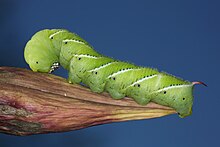Tobacco hornworm
| Manduca sexta | |
|---|---|
 |
|
 |
|
| Scientific classification | |
| Kingdom: | Animalia |
| Clade: | Euarthropoda |
| Class: | Insecta |
| Order: | Lepidoptera |
| Family: | Sphingidae |
| Genus: | Manduca |
| Species: | M. sexta |
| Binomial name | |
|
Manduca sexta (Linnaeus, 1763) |
|
| Synonyms | |
|
|
Manduca sexta is a moth of the family Sphingidae present through much of the American continent.
Commonly known as the Carolina sphinx moth and the tobacco hawk moth (as adults) and the tobacco hornworm and the goliath worm (as larvae), it is closely related to and often confused with the very similar tomato hornworm (Manduca quinquemaculata); the larvae of both feed on the foliage of various plants of the family Solanaceae. The tobacco hornworm is sometimes kept as a pet by children throughout its range. The larvae of these species can be distinguished by their lateral markings: Tomato hornworms have eight V-shaped white markings with no borders; tobacco hornworms have seven white diagonal lines with a black border. Additionally, tobacco hornworms have red horns, while tomato hornworms have dark blue or black horns. A mnemonic to remember the markings is tobacco hornworms have straight white lines like cigarettes, while tomato hornworms have V-shaped markings (as in "vine-ripened" tomatoes). M. sexta has mechanisms for selectively sequestering and secreting the neurotoxin nicotine present in tobacco.
M. sexta is a common model organism, especially in neurobiology, due to its easily accessible nervous system and short life cycle. It is used in a variety of biomedical and biological scientific experiments. It can be easily raised on a wheat-germ-based diet. The larva is large, and thus it is relatively easy to dissect it and isolate its organs.
M. sexta has a short life cycle, lasting about 30 to 50 days. In most areas, M. sexta has about two generations per year, but can have three or four generations per year in Florida.
M. sexta eggs are spherical, approximately 1.5 millimeters in diameter, and translucent green in color. They typically hatch two to four days after they are laid. Eggs are normally found on the underside of foliage, but can also be found on the upper surface.
M. sexta larvae are green in color and grow up to 70 millimeters in length. Under laboratory conditions, when fed a wheat-germ based diet, larvae are turquoise due to a lack of pigments in their diet. M. sexta hemolymph (blood) contains the blue-colored protein insecticyanin. When the larva feeds on plants, it ingests pigmentacious carotenoids. Carotenoids are primarily yellow in hue. The resulting combination is green.
...
Wikipedia
